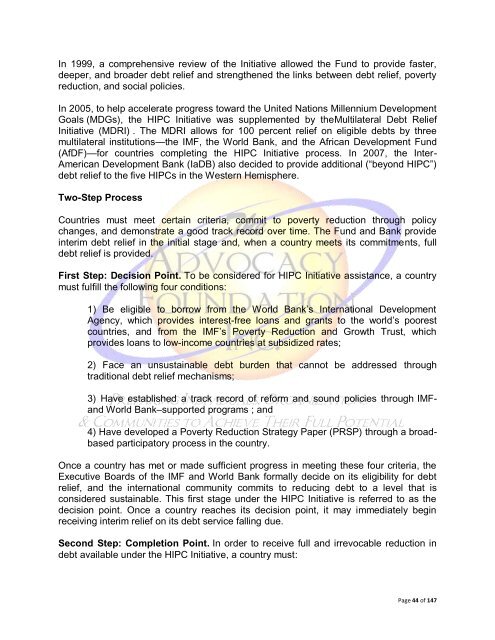Debt Reduction & Debt Relief
Debt Reduction & Debt Relief
Debt Reduction & Debt Relief
You also want an ePaper? Increase the reach of your titles
YUMPU automatically turns print PDFs into web optimized ePapers that Google loves.
In 1999, a comprehensive review of the Initiative allowed the Fund to provide faster,<br />
deeper, and broader debt relief and strengthened the links between debt relief, poverty<br />
reduction, and social policies.<br />
In 2005, to help accelerate progress toward the United Nations Millennium Development<br />
Goals (MDGs), the HIPC Initiative was supplemented by theMultilateral <strong>Debt</strong> <strong>Relief</strong><br />
Initiative (MDRI) . The MDRI allows for 100 percent relief on eligible debts by three<br />
multilateral institutions—the IMF, the World Bank, and the African Development Fund<br />
(AfDF)—for countries completing the HIPC Initiative process. In 2007, the Inter-<br />
American Development Bank (IaDB) also decided to provide additional (“beyond HIPC”)<br />
debt relief to the five HIPCs in the Western Hemisphere.<br />
Two-Step Process<br />
Countries must meet certain criteria, commit to poverty reduction through policy<br />
changes, and demonstrate a good track record over time. The Fund and Bank provide<br />
interim debt relief in the initial stage and, when a country meets its commitments, full<br />
debt relief is provided.<br />
First Step: Decision Point. To be considered for HIPC Initiative assistance, a country<br />
must fulfill the following four conditions:<br />
1) Be eligible to borrow from the World Bank’s International Development<br />
Agency, which provides interest-free loans and grants to the world’s poorest<br />
countries, and from the IMF’s Poverty <strong>Reduction</strong> and Growth Trust, which<br />
provides loans to low-income countries at subsidized rates;<br />
2) Face an unsustainable debt burden that cannot be addressed through<br />
traditional debt relief mechanisms;<br />
3) Have established a track record of reform and sound policies through IMFand<br />
World Bank–supported programs ; and<br />
4) Have developed a Poverty <strong>Reduction</strong> Strategy Paper (PRSP) through a broadbased<br />
participatory process in the country.<br />
Once a country has met or made sufficient progress in meeting these four criteria, the<br />
Executive Boards of the IMF and World Bank formally decide on its eligibility for debt<br />
relief, and the international community commits to reducing debt to a level that is<br />
considered sustainable. This first stage under the HIPC Initiative is referred to as the<br />
decision point. Once a country reaches its decision point, it may immediately begin<br />
receiving interim relief on its debt service falling due.<br />
Second Step: Completion Point. In order to receive full and irrevocable reduction in<br />
debt available under the HIPC Initiative, a country must:<br />
Page 44 of 147

















